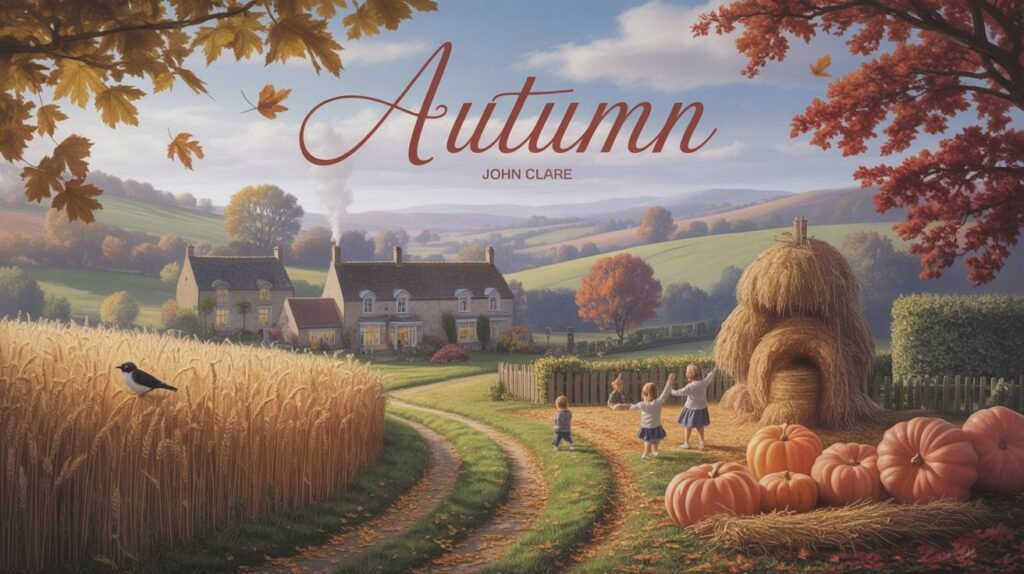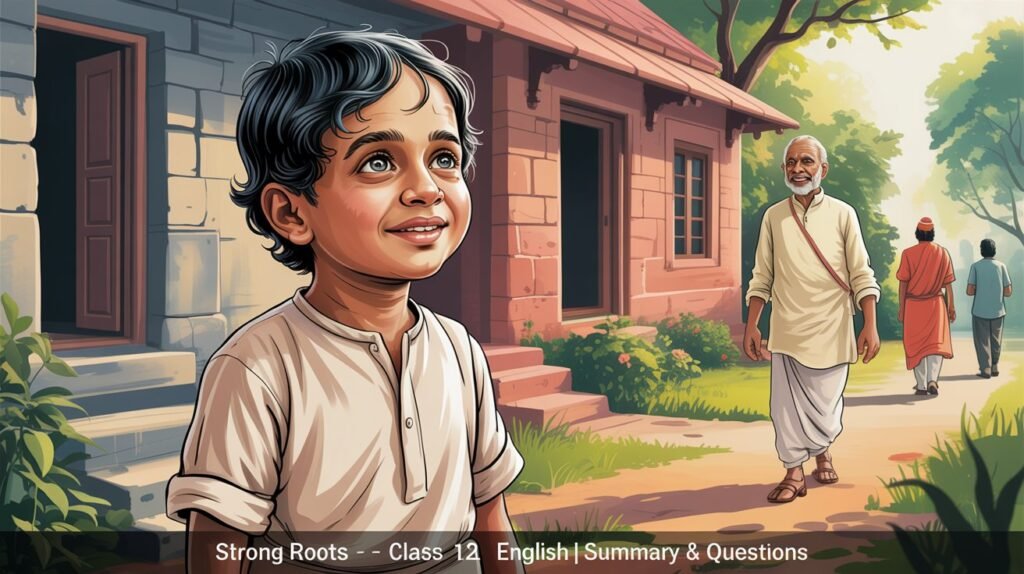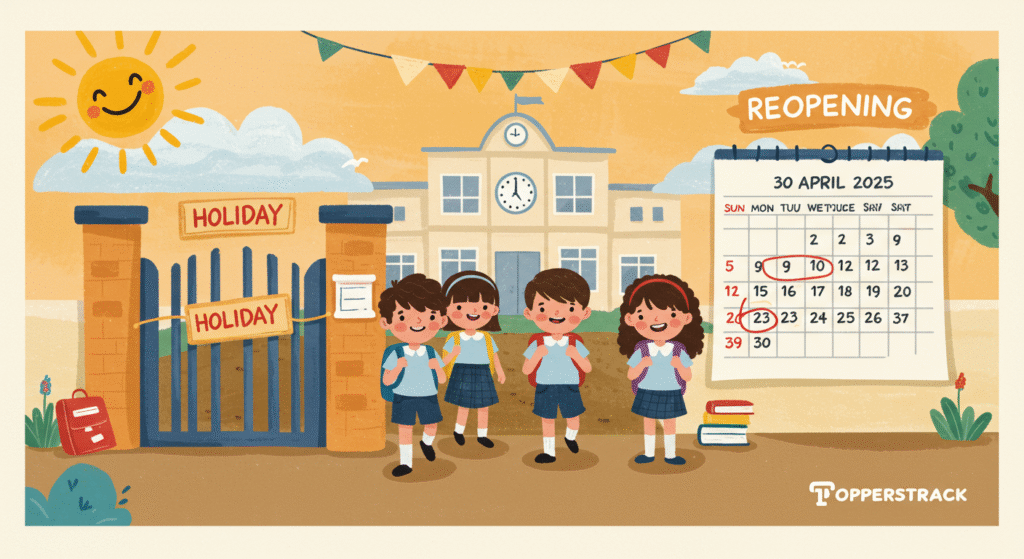
"Autumn" by John Clare Summary, Questions with Answers: Class 9 English Syllabus
"Autumn" কবিতাটি ইংরেজ কবি John Clare রচিত একটি প্রকৃতিনির্ভর কবিতা, যেখানে তিনি শরৎ ঋতুর সৌন্দর্য, শান্ত পরিবেশ এবং গ্রামীণ জীবনের চিত্র সুন্দরভাবে তুলে ধরেছেন। এই কবিতায় প্রকৃতির রঙ, কৃষকের কর্মব্যস্ততা, পাখিদের গান এবং ফলের পক্বতা — সবকিছুই একটি মনোরম ও শান্ত ছবির মতো উপস্থাপিত হয়েছে। Clare এই কবিতার মাধ্যমে আমাদের শরৎ ঋতুর স্নিগ্ধতা ও প্রকৃতির প্রতি ভালোবাসা অনুভব করাতে চেয়েছেন।
Autumn
-John Clare
The thistledown's flying, though the winds are all still,
On the green grass now lying, now mounting the hill,
The spring from the fountain now boils like a pot;
Through stones past the counting it bubbles red-hot.
The ground parched and cracked is like overbaked bread,
The greensward all wracked is, bents dried up and dead.
The fallow fields glitter like water indeed,
And gossamers twitter, flung from weed unto weed.
Hill-tops like hot iron glitter bright in the sun,
And the rivers we're eying burn to gold as they run;
Burning hot is the ground, liquid gold is the air;
Whoever looks round sees Eternity there.
Summary of "Autumn" by John Clare: Class 9 English Syllabus
The poem "Autumn" by John Clare describes the beautiful sights and sounds of the autumn season in the countryside. The poet talks about golden leaves, ripened fruits, singing birds, and the calmness of nature. He shows how farmers work in the fields, and how animals prepare for winter. Clare paints a peaceful and joyful picture of rural life during autumn, making us feel the quiet beauty of the season. The poem celebrates nature’s changes with love and deep observation.
Summary of "Autumn" by John Clare in Bengali: Class 9 English Syllabus
"Autumn" কবিতায় John Clare শরৎ ঋতুর প্রাকৃতিক সৌন্দর্য ও গ্রামীণ জীবনের শান্ত দৃশ্যগুলো বর্ণনা করেছেন। তিনি দেখিয়েছেন কিভাবে গাছের পাতা ঝরে পড়ে, শস্য ক্ষেতগুলো পরিপূর্ণ হয়, পাখিরা গান গায় এবং মানুষজন মাঠে কাজ করে। কবি শরৎ ঋতুর নিঃশব্দ, শান্ত পরিবেশ ও প্রকৃতির রঙিন রূপকে ভালোবাসা ও আনন্দের সঙ্গে তুলে ধরেছেন। এই কবিতাটি আমাদের প্রকৃতির প্রতি ভালোবাসা ও প্রশান্তি অনুভব করতে সাহায্য করে।
MCQs on "Autumn" by John Clare: Class 9 English Syllabus
- Who is the poet of the poem "Autumn"?
a) William Wordsworth
b) John Clare
c) Robert Frost
d) Percy Shelley
Answer: b) John Clare - What season is described in the poem?
a) Spring
b) Summer
c) Autumn
d) Winter
Answer: c) Autumn - What does John Clare see in the fields during autumn?
a) Flowers blooming
b) Ripe fruits and crops
c) Snow covering the ground
d) Birds flying south
Answer: b) Ripe fruits and crops - How does the poet describe the weather in autumn?
a) Cold and snowy
b) Warm and sunny
c) Fresh and mild
d) Stormy and windy
Answer: c) Fresh and mild
"Autumn" by John Clare Summary, Questions with Answers: Class 9 English Syllabus
- What sound is often heard in autumn according to the poem?
a) Birdsong
b) Leaves rustling
c) Thunder
d) Ocean waves
Answer: b) Leaves rustling - What does the poet feel about autumn?
a) Sadness
b) Joy and pleasure
c) Fear
d) Anger
Answer: b) Joy and pleasure - What does the poet mention about the birds in autumn?
a) They migrate away
b) They sing beautifully
c) They stop singing
d) They sleep all day
Answer: b) They sing beautifully - The phrase "soft dying day" refers to:
a) A bright day
b) A peaceful evening
c) A cold morning
d) A rainy afternoon
Answer: b) A peaceful evening - Which word best describes the tone of the poem?
a) Melancholy
b) Hopeful
c) Joyful
d) Angry
Answer: c) Joyful - What is the main theme of the poem "Autumn"?
a) Nature's beauty in autumn
b) The harshness of winter
c) The sadness of loss
d) The arrival of spring
Answer: a) Nature's beauty in autumn - What kind of imagery is used in the poem?
a) Visual imagery
b) Auditory imagery
c) Tactile imagery
d) All of the above
Answer: d) All of the above - Which of the following best describes the mood of the poem?
a) Cheerful and calm
b) Gloomy and dark
c) Excited and loud
d) Fearful and tense
Answer: a) Cheerful and calm
"Autumn" by John Clare Summary, Questions with Answers: Class 9 English Syllabus
- What does "gleams the fading year" suggest?
a) The year is ending beautifully
b) The year is dark and cold
c) The year is starting
d) The year is forgotten
Answer: a) The year is ending beautifully - How does the poet feel about the harvest?
a) He ignores it
b) He feels proud and happy
c) He is scared of it
d) He dislikes it
Answer: b) He feels proud and happy - What effect does autumn have on nature in the poem?
a) Makes everything grow
b) Shows nature’s richness before winter
c) Kills all plants
d) Brings snow and ice
Answer: b) Shows nature’s richness before winter - The phrase "the red-breast whistles" means:
a) A person is whistling
b) A bird is singing
c) A wind is blowing
d) A machine is working
Answer: b) A bird is singing - Which season follows autumn in the poem?
a) Spring
b) Summer
c) Winter
d) Rainy
Answer: c) Winter - What does "the woods are bare" indicate?
a) Trees have no leaves
b) Trees are green
c) Trees have flowers
d) Trees are growing fast
Answer: a) Trees have no leaves
"Autumn" by John Clare Summary, Questions with Answers: Class 9 English Syllabus
- How is the harvest described?
a) Poor and small
b) Large and plentiful
c) Late and missed
d) Spoiled and rotten
Answer: b) Large and plentiful - Which of the following is a key symbol in the poem?
a) The moon
b) The harvest
c) The river
d) The sun
Answer: b) The harvest - The "rustling leaves" symbolize:
a) Death
b) Change and transition
c) Calmness
d) Silence
Answer: b) Change and transition - What kind of poet is John Clare?
a) Romantic poet
b) Modern poet
c) Victorian poet
d) Postmodern poet
Answer: a) Romantic poet - Which sense is mostly appealed to in the poem?
a) Sight
b) Hearing
c) Touch
d) Smell
Answer: a) Sight - The poem "Autumn" is mainly about:
a) The sadness of nature
b) The beauty and richness of autumn
c) The coldness of winter
d) The arrival of spring
Answer: b) The beauty and richness of autumn - What is the rhyme scheme of the poem?
a) ABAB
b) AABB
c) ABCB
d) Free verse
Answer: a) ABAB - What does the poet compare the harvest to?
a) A bright light
b) A golden gift
c) A heavy burden
d) A lost treasure
Answer: b) A golden gift - Which bird is mentioned in the poem?
a) Sparrow
b) Red-breast
c) Owl
d) Eagle
Answer: b) Red-breast - The overall tone of the poem is:
a) Sad and gloomy
b) Peaceful and thankful
c) Angry and frustrated
d) Excited and nervous
Answer: b) Peaceful and thankful
"Autumn" by John Clare Summary, Questions with Answers: Class 9 English Syllabus
- The phrase "yellow fields" refers to:
a) Ripened crops ready to harvest
b) Autumn flowers
c) Early spring leaves
d) Dead plants
Answer: a) Ripened crops ready to harvest - John Clare was born in:
a) London
b) Northamptonshire
c) Oxford
d) Cambridge
Answer: b) Northamptonshire - What kind of language is used in the poem?
a) Simple and natural
b) Complex and difficult
c) Technical
d) Formal and official
Answer: a) Simple and natural - The poem celebrates:
a) Urban life
b) Industrial progress
c) Rural beauty and harvest
d) War and victory
Answer: c) Rural beauty and harvest - Which of these is NOT mentioned in the poem?
a) Harvest
b) Birds
c) Snow
d) Rustling leaves
Answer: c) Snow - The phrase “the fading year” means:
a) The year is getting older and coming to an end
b) The year is new and fresh
c) The year is warm
d) The year is dark
Answer: a) The year is getting older and coming to an end - What is the mood of the poem?
a) Cheerful and calm
b) Sad and gloomy
c) Angry and tense
d) Fearful and dark
Answer: a) Cheerful and calm - The poet’s attitude towards autumn is:
a) Negative
b) Indifferent
c) Positive and appreciative
d) Fearful
Answer: c) Positive and appreciative
"Autumn" by John Clare Summary, Questions with Answers: Class 9 English Syllabus
- The harvest is described as:
a) A time of plenty
b) A time of loss
c) A time of darkness
d) A time of sorrow
Answer: a) A time of plenty - The “yellow fields” suggest:
a) Drought
b) Ripeness and abundance
c) Winter cold
d) Early spring
Answer: b) Ripeness and abundance - The poem "Autumn" belongs to which literary period?
a) Romantic
b) Modernist
c) Victorian
d) Renaissance
Answer: a) Romantic - Which of the following is a theme of the poem?
a) The passage of time
b) Industrial growth
c) City life
d) Technology
Answer: a) The passage of time - The poet enjoys the sight of:
a) Flowers only
b) Birds and fields
c) Snow and ice
d) Fire and smoke
Answer: b) Birds and fields - What is the main emotion conveyed by the poem?
a) Joy and contentment
b) Sadness and grief
c) Anger and frustration
d) Fear and anxiety
Answer: a) Joy and contentment - What season is described as the "soft dying day"?
a) Autumn evening
b) Summer morning
c) Winter night
d) Spring afternoon
Answer: a) Autumn evening - The poem emphasizes the beauty of:
a) Urban settings
b) Nature and countryside
c) Factories
d) War scenes
Answer: b) Nature and countryside - Which bird's song is highlighted in the poem?
a) Nightingale
b) Red-breast
c) Crow
d) Parrot
Answer: b) Red-breast - The phrase “gleams the fading year” suggests:
a) The year is ending with brightness
b) The year is getting dark
c) The year is starting
d) The year is cold
Answer: a) The year is ending with brightness
"Autumn" by John Clare Summary, Questions with Answers: Class 9 English Syllabus
- Which sense is NOT strongly appealed to in the poem?
a) Sight
b) Hearing
c) Smell
d) Taste
Answer: d) Taste - What does the poet see in the fields?
a) Snow and ice
b) Ripe crops and golden harvest
c) Empty lands
d) Flowers only
Answer: b) Ripe crops and golden harvest - John Clare is famous for writing about:
a) Nature and rural life
b) Politics
c) Cities
d) Science
Answer: a) Nature and rural life - The overall message of the poem is to:
a) Appreciate the beauty of autumn and nature
b) Fear the coming winter
c) Avoid outdoor activities
d) Work hard in cities
Answer: a) Appreciate the beauty of autumn and nature
Fill in the Blanks on "Autumn" by John Clare: Class 9 English Syllabus
- The poet of the poem "Autumn" is ________.
Answer: John Clare - The poem describes the season of ________.
Answer: Autumn - In autumn, the fields are full of ripe ________.
Answer: crops / harvest - The poet hears the rustling of ________ in the trees.
Answer: leaves
"Autumn" by John Clare Summary, Questions with Answers: Class 9 English Syllabus
- The red-breast bird is known for its ________.
Answer: whistle / song - The weather in autumn is usually ________ and mild.
Answer: fresh - The poem describes the year as "fading," meaning it is ________.
Answer: ending / coming to an end - Autumn is the season before ________.
Answer: winter - The poet uses ________ imagery to describe the fields.
Answer: visual - John Clare was a famous ________ poet.
Answer: romantic - The fields in autumn are often yellow or ________ in color.
Answer: golden - The leaves in autumn often ________ and fall to the ground.
Answer: rustle - The phrase "soft dying day" refers to the ________.
Answer: evening - Autumn brings the time of the ________.
Answer: harvest - The poem expresses feelings of ________ about autumn.
Answer: joy / pleasure - The "gleaming" of the fading year means the year is ending ________.
Answer: beautifully - The poem appeals mainly to the sense of ________.
Answer: sight - The birds in the poem are described as ________ and singing.
Answer: cheerful - Autumn is described as a time of ________ and plenty.
Answer: abundance
"Autumn" by John Clare Summary, Questions with Answers: Class 9 English Syllabus
- John Clare was born in ________ county.
Answer: Northamptonshire - The poet enjoys the beauty of the ________ countryside.
Answer: rural - The phrase "rustling leaves" suggests ________ and change.
Answer: movement - The harvest is a symbol of ________ in the poem.
Answer: plenty / richness - The poem's tone is calm and ________.
Answer: peaceful - John Clare’s poetry often celebrates ________ life.
Answer: country / rural - The poem's rhyme scheme is ________.
Answer: ABAB - The "yellow fields" symbolize ripe ________.
Answer: crops - Autumn follows the ________ season.
Answer: summer - The "red-breast" is a type of ________.
Answer: bird - The phrase "fading year" indicates the passage of ________.
Answer: time - The poem "Autumn" is written in ________ language.
Answer: simple - The mood of the poem is mostly ________ and thankful.
Answer: joyful - The "soft dying day" is a ________ autumn evening.
Answer: peaceful - John Clare’s poetry belongs to the ________ literary period.
Answer: Romantic - The poet feels ________ about the changes in nature.
Answer: happy / content - The leaves fall because the trees become ________.
Answer: bare - The red-breast whistles a ________ song.
Answer: cheerful - The poem describes the richness of the autumn ________.
Answer: harvest - The poet’s tone is full of ________ for nature.
Answer: love / appreciation
"Autumn" by John Clare Summary, Questions with Answers: Class 9 English Syllabus
- The season after autumn is called ________.
Answer: winter - The poet watches the ________ fields and trees.
Answer: yellow / golden - The word "gleams" means to ________.
Answer: shine / glow - The poem praises the ________ and beauty of autumn.
Answer: colors - Autumn is the time when crops are ________.
Answer: gathered / harvested - John Clare’s poetry often describes the beauty of ________.
Answer: nature - The poet feels that autumn days are soft and ________.
Answer: calm - The fields are rich and full of ________ in autumn.
Answer: grain / crops - The poet sees the countryside with a feeling of ________.
Answer: joy - The "rustling leaves" make a gentle ________ sound.
Answer: whispering - The poem "Autumn" invites readers to enjoy the season’s ________.
Answer: beauty
Short Answer Questions (SAQs) on "Autumn" by John Clare: Class 9 English Syllabus
- Who wrote the poem "Autumn"?
Answer: John Clare wrote the poem "Autumn." - What is the main subject of the poem?
Answer: The poem describes the beauty and richness of the autumn season. - How does the poet describe the fields in autumn?
Answer: The poet describes the fields as yellow and golden, full of ripe crops ready for harvest. - What sounds are mentioned in the poem?
Answer: The poem mentions the rustling of leaves and the whistle of the red-breast bird. - What mood does the poem "Autumn" create?
Answer: The poem creates a calm, joyful, and peaceful mood.
"Autumn" by John Clare Summary, Questions with Answers: Class 9 English Syllabus
- What does the phrase "soft dying day" mean?
Answer: It refers to a peaceful autumn evening when the day is ending softly. - Why is autumn called the "fading year"?
Answer: Because autumn is the last season before the year ends and winter begins. - What is the poet’s attitude towards autumn?
Answer: The poet appreciates and enjoys the beauty and richness of autumn. - How does the poet use imagery in the poem?
Answer: The poet uses visual imagery of golden fields and auditory imagery like the whistle of birds. - What does the harvest symbolize in the poem?
Answer: The harvest symbolizes abundance and the rewards of nature’s cycle. - Which bird is mentioned in the poem and what does it do?
Answer: The red-breast bird is mentioned, and it whistles or sings cheerfully. - How does the poem reflect the passing of time?
Answer: The poem shows autumn as the final stage of the year before winter, indicating the passing of time. - Why are the leaves described as "rustling"?
Answer: Because they make a soft sound as they move in the breeze. - What kind of feelings does autumn evoke in the poet?
Answer: Feelings of joy, peace, and appreciation for nature. - How does the poem portray the countryside?
Answer: The countryside is portrayed as beautiful, calm, and full of life during autumn. - What happens to the trees in autumn according to the poem?
Answer: The trees become bare as their leaves fall. - What literary period does John Clare belong to?
Answer: John Clare belongs to the Romantic literary period. - Why is the poem suitable for class 9 students?
Answer: Because it uses simple language and describes nature in an easy-to-understand way.
"Autumn" by John Clare Summary, Questions with Answers: Class 9 English Syllabus
- What is the tone of the poem?
Answer: The tone is calm, joyful, and thankful. - What season comes after autumn?
Answer: Winter comes after autumn. - What colors are associated with autumn in the poem?
Answer: Yellow and golden colors are associated with autumn. - What does the phrase "gleams the fading year" mean?
Answer: It means the year is ending with a bright and beautiful glow. - How is nature described in the poem?
Answer: Nature is described as full of beauty, life, and abundance. - What sounds can be heard in the autumn countryside?
Answer: The rustling of leaves and the whistles of birds. - What message does the poem give to the reader?
Answer: The poem encourages readers to appreciate the beauty of autumn and nature. - How does John Clare’s background influence this poem?
Answer: Being a rural poet, Clare’s love for countryside and nature is reflected in the poem. - What is the rhyme scheme of the poem?
Answer: The rhyme scheme is ABAB. - How does the poem use sensory details?
Answer: It uses sight (colors of fields), sound (bird whistles, rustling leaves), and touch (soft dying day) imagery. - What is the significance of the harvest in the poem?
Answer: It represents the time of plenty and reward from the earth. - How does the poet feel about the changing seasons?
Answer: The poet feels content and joyful about the natural changes. - Why is the poem titled "Autumn"?
Answer: Because it focuses on the season of autumn and its characteristics. - What changes happen in nature during autumn as per the poem?
Answer: Leaves fall, crops ripen, and birds sing before winter. - What is the effect of the poem’s imagery?
Answer: It creates a vivid picture of autumn’s beauty in the reader’s mind.
"Autumn" by John Clare Summary, Questions with Answers: Class 9 English Syllabus
- How is the countryside described during the harvest time?
Answer: It is described as rich, golden, and full of life. - What is the poet’s attitude towards the cycle of the year?
Answer: The poet appreciates the natural cycle and its stages. - What feeling does the "rustling leaves" evoke?
Answer: A feeling of calmness and gentle movement. - How does the poem depict birds?
Answer: Birds are cheerful and their whistles add to the beauty of autumn. - What does the phrase “yellow fields” suggest about the crops?
Answer: The crops are ripe and ready for harvest. - How does the poet describe the atmosphere of autumn evenings?
Answer: As soft, calm, and peaceful. - Why is the poem considered a Romantic poem?
Answer: Because it celebrates nature and emotions. - What does the "fading year" symbolize?
Answer: The end of the year and the passing of time. - What natural elements are prominent in the poem?
Answer: Fields, leaves, birds, and weather.
"Autumn" by John Clare Summary, Questions with Answers: Class 9 English Syllabus
- How does the poet use the senses to describe autumn?
Answer: By describing sights, sounds, and the gentle feel of the day. - What does the poem suggest about the relationship between humans and nature?
Answer: It suggests harmony and appreciation. - What lesson can students learn from the poem?
Answer: To appreciate the beauty of nature and seasonal changes. - How does the poem end?
Answer: With a peaceful image of autumn and the passing year. - What type of imagery is most dominant in the poem?
Answer: Visual imagery - What is the significance of the bird’s whistle in the poem?
Answer: It adds a joyful and lively sound to the autumn scene. - Why does the poet describe autumn as “soft”?
Answer: Because the days are gentle and calm before winter. - How does the poem reflect John Clare’s love for nature?
Answer: Through detailed, loving descriptions of rural autumn scenes.
জন ক্লেয়ারের "অটাম" কবিতাটি প্রকৃতির রূপের এক অসাধারণ চিত্রণ। এই কবিতায় কবি প্রতিটি শুষ্ক ঋতুর স্বর্ণালী আভা এবং ফলনশীলতা সুন্দরভাবে উপস্থাপন করেছেন। শরৎকালকে তিনি এক ধরনের শান্তি ও আনন্দের প্রতীক হিসেবে দেখিয়েছেন, যেখানে প্রকৃতি তার সম্পদ উজাড় করে এবং আসন্ন শীতের প্রস্তুতি নেয়। কবিতাটি আমাদের শেখায় প্রকৃতির পরিবর্তনকে ভালোবেসে গ্রহণ করতে এবং প্রকৃতির সৌন্দর্যকে উপভোগ করার গুরুত্ব। তাই "অটাম" কবিতাটি শিক্ষার্থীদের জন্য ঋতুর পরিবর্তনের প্রতি সচেতনতা ও প্রশান্তি অর্জনের এক অনন্য উৎস।
🔔 পরবর্তী আপডেট সম্পর্কে গুরুত্বপূর্ণ তথ্য:
এই প্রশ্নোত্তর তালিকায় ভবিষ্যতে যদি আরও নতুন প্রশ্ন যোগ করা হয়, তাহলে তোমরা এখানেই আপডেট পেয়ে যাবে। পাশাপাশি, আমাদের Topperstrack.in অ্যাপ-এর কোর্সে তোমরা পাবে –
✅ সাজেশন, উত্তরপত্র এবং রিভিশন সেট
✅ অধ্যায়ভিত্তিক স্টাডি রিসোর্স
✅ নিয়মিত মক টেস্ট ও কুইজ
🔔 পড়াশোনাকে আরও সহজ ও মজাদার করতে আমাদের সঙ্গেই থাকুন!
✅ এখনই যুক্ত হোন আমাদের 📚 Study Group-এ, যেখানে প্রতিদিন পাবেন গুরুত্বপূর্ণ নোটস, MCQ প্রশ্ন, সাজেশন এবং পরীক্ষা প্রস্তুতির টিপস!
👉 টেলিগ্রাম গ্রুপে যুক্ত হতে ক্লিক করুন:
📲 Join Telegram
👉 হোয়াটসঅ্যাপ চ্যানেলে যুক্ত হতে ক্লিক করুন:
📲 Join WhatsApp Channel
🎯 পড়াশোনা হোক আরও সহজ, গাইডলাইন থাক আমাদের সঙ্গেই!
👥 বন্ধুদের সাথেও শেয়ার করতে ভুলবেন না! 📖✨
💡 এছাড়াও আমাদের অফিসিয়াল ওয়েবসাইট 🌐 Topperstrack.in
এ গেলে তোমরা আরও অনেক বিষয়ভিত্তিক প্রস্তুতি ও শিক্ষনীয় সামগ্রী পাবে!
📱 তাই দেরি না করে এখনই Topperstrack.in অ্যাপ ডাউনলোড করো এবং Topperstrack.in -এ ভিজিট করে নিয়মিত প্র্যাকটিসে থাকো।
Related Articles:
- “All about a Dog” by A. G. Gardiner Summary, Questions and Answers: Class 9 English Syllabus
- Durrell Summary, Questions and Answers: Class 9 WBBSE English Syllabus
- “His First Flight” by Liam O’Flaherty Summary, Questions and Answers: Class 9 English Syllabus
- “All Summer in a Day” by Ray Bradbury Summary, Questions and Answers: Class 9 WBBSE English Syllabus
- “Mild the Mist upon the Hill” by Emily Jane Bronte Summary, Questions and Answers: Class 9 WBBSE Syllabus
- “Tom Loses a Tooth” by Mark Twain Summary, Questions and Answers: Class 9 WBSSE Syllabus
- The North Ship by Philip Larkin Summary, Questions and Answers: Class 9 WBBSE Syllabus
- “The Price of Bananas” by Mulk Raj Anand Summary, Questions and Answers: Class 9 WBBSE Syllabus
- “A Shipwrecked Sailor” by Daniel Defoe Summary, Questions and Answers: Class 9 WBBSE Syllabus
- “Hunting Snake” by Judith Wright Summary, Questions and Answers: Class 9 WBBSE Syllabus



